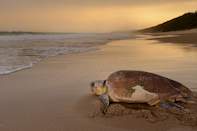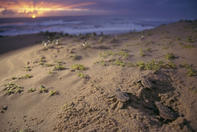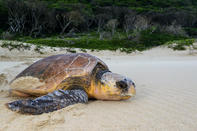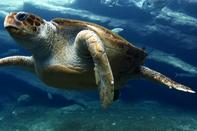Turtle Nesting
Around November each year, on bright moonlit nights, one of the most mesmerising acts of nature begins: female loggerhead and leatherback turtles (the latter reaching 1.7 m and 400 kg) haul themselves through the surf zone in Maputaland, KZN to lay their eggs.

The process - dragging themselves above the high-tide mark, digging a big enough hole with their front flippers, laying up to 50 eggs (one at a time), covering their nests, and then heading back out to sea — can take several hours. Written explanations do it little justice, but it is a most heart-stirring thing to witness.
Hatching of Baby Turtles

Both the loggerhead and leatherback turtles start hauling up on the beaches of Maputaland around mid-November. It is an arduous process when your best tools are two front flippers,
you are used to a weightless life in the water and you can weigh anything from 200 to 700 kilograms. By mid-January most of the females have deposited their full load of as many as 1,000 eggs and head off out to sea again, until the next summer.
From mid-January another little miracle begins, the hatching. There are usually around 100 eggs in a batch. Having survived all the threats of predation, collapsing beaches, desiccation and overheating, the surviving turtle babies have to break out of the leathery egg sacs and then clamber up through a metre or two of sand to the surface.
It is now that their race of death really begins as ghost crabs, monitor lizards, mongooses and seagulls swarm in to pick them off. It is a numbers game, with only a very small percentage of
hatchlings making it into the surf— just one or two for every thousand eggs laid. Once there, a whole new package of dangers awaits, without any adult supervision. Somewhere between 16
and 20 years later the surviving females will return to a beach in Maputaland and the cycle will repeat itself.
Turtle History

For centuries sea turtles, especially the green species abundant in the northern waters, were the favourite food of sailors with the soup fetching very high prices among the well-to-do of Europe and elsewhere. It was so easy to catch turtles when they hauled themselves up onto tropical beaches to dig nests in which to lay their clutches of soft, leathery eggs, it did not take long for them to become among the first creatures of the seas to confront the evolutionary end-game.
But what had the greatest impact on sea turtles was the slave trade: nothing was easier or cheaper than to feed that sad human cargo with turtles and eggs loaded up from all the remote beaches and islands of the Indian and Atlantic Oceans. Few people know a shoreline better than avid coastal anglers. In the early 1960s it therefore came as a surprise to senior staff at the Natal Parks Board, (now Ezemvelo KZN Wildlife, the conservation authority in KwaZulu-Natal, South Africa) who themselves were keen fishermen and familiar with the remote northern beaches, to hear that a turtle graveyard had been discovered south of Kosi Bay near the Mozambique border.
Protecting Turtles

No turtle had ever been recorded from the region, and yet clearly they existed and people were eating them. As a result the Parks Board instituted the first turtle monitoring and tagging programme in the summer of 1963/64 along the Maputaland beaches. It has been running ever since, amassing one of the most comprehensive bodies of turtle data in the world.
In recent decades the shoreline and marine margin has been protected as part of the iSimangaliso Wetland Park, a semi-autonomous conservation organisation that protects not only wildlife and natural habitat, but also safeguards the way of life and development of the subsistence Nguni people who live there.
Of the seven species of sea turtle found worldwide, five of them (leatherback, loggerhead, green hawksbill and olive Ridley) are found in the sea off iSimangaliso. Only two, however, the leatherback and the loggerhead, come ashore to lay. Even though their numbers have been increasing slowly over recent decades, turtle futures here, as worldwide, are by no means bank safe.